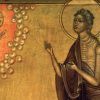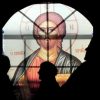Mary of Nazareth has been given many titles over the last two millennia. She is called the Virgin Mary, Theotokos (Greek: “Birthgiver of God”), Panagia (Greek: “All Holy One”), the Blessed Mother and Our Lady to name a few. No other woman has achieved such enduring fame and influence than has Jesus’ mother Mary.
Through eyes of the world, Mary is a historical curiosity. Through the eyes of the Christian however, Mary is the preeminent follower of Jesus and an example to all believers. Everything she does and says points to her Son.
A Life of Virtue
Early on in the New Testament, we see Mary’s as the paradigmatic “handmaiden of the Lord.” Mary’s cousin Elizabeth greeted her while she was pregnant saying, “In a loud voice she exclaimed, ‘Blessed are you among women and blessed in the fruit of your womb!’ But why am I so favored that the mother of my Lord should come to me?’” (Luke 1:43).
Later in the scriptures we following the Ascension of the Lord, Mary is the only person mentioned by name in the Upper Room alongside the disciples following their return from the Mount of Olives (Acts 1:14).
Clearly we can see the importance placed on Mary from the earliest days of the Church. Let us explore some of the key virtues which we can learn from her.
Obedience
First, in Mary we find the epitome of Christian obedience. We read in the Gospel of Luke, that the Archangel Gabriel appeared to Mary announcing that she had found favor with God and that she was the chosen vessel to bear the Messiah telling her, “For nothing will be impossible with God” (Luke 1:37). Her simple and humble response was, “Behold, I am the handmaiden of the Lord; let it be done to me according to thy word” (Luke 1:38).
As an engaged Jewish teenager in first century Palestine, Mary makes her startling proclamation despite the social stigma, familial estrangement and debilitating economic consequences her obedience might bring about.
None of this was done recklessly. Rather, obedience compelled confidence and deeper praise to God. It enabled Mary to proclaim to her Elizabeth, “My soul magnifies the Lord, and my spirit rejoices in God my Savior, for He has looked on the low estate of His handmaiden. For behold, from on all generations will call me blessed; for He who is mighty has done great things for me and holy is His Name” (Luke 1:47-49).
Throughout her life Mary lived in obedience to God. She faithfully worshiped and served Him at home with her parents Joachim and Anna, in her community in Nazareth, at the Jerusalem Temple, at the foot of the Cross, at the empty tomb on the third day, at the Ascension of the Lord, and in the Upper Room at Pentecost. Mary continues to serve her Son in the Kingdom of Heaven through her unceasing prayers and intercessions for the entire world.
Mary never stopped to ponder the cost of her obedience despite the fear and uncertainty it undoubtedly caused. Her response was a consistent, “Let it be it done to me according to thy will.”
Prayer
Second, in Mary, we find the epitome of prayer. Mary is a person of prayer. The call to bear the Son of God required a special type of person, one rooted in unceasing prayer. Without this level and dimension of prayer, she simply would be unequipped to experience and comprehend the mystery of communion with the Holy Trinity in the ways that she did.
The goal of every Christian is to enter into the communion with God in which Mary lived. As Mary prayed so must we learn how to pray. Mary prayed for herself and prays for others. In fact, the first miracle recorded in the New Testament is Mary imploring her Son Jesus at the wedding at Cana of Galilee to do something since the banquet had run out of wine (John 2:1-12).
Mary is an example to us. She is what Christians need to become. This is illustrated in the Orthodox Church in the Feast (Celebration) of the Entrance of the Theotokos (Mary) into the Temple.
The hymnography of the Feast teaches that Mary was taken at age three by her aged parents to the Jerusalem Temple to live a life of service to God as a consecrated virgin. Once there, she ascended up the steps of the Temple unaided as the High Priest awaited her to take her into the Holy of Holies.
The second century apocryphal Gospel of James (Protevangelium) mentions the early upbringing of Mary in greater detail. Interestingly, a similar prefigurative reference can be found in the Old Testament in the person of Samuel when Hannah took him to the Tabernacle (1 Samuel 1:22).
The earliest existent biography as such that we have on Mary is from the seventh century entitled The Life of the Virgin written by St. Maximos the Confessor. In St. Maximos’ work, Mary is portrayed as a key influence in the life of the early Church.
Prayer was also at the core of all of these significant occurrences. Mary’s parents prayed to God for a child. Mary spent a life in private personal prayer and formal congregational corporate prayer. Mary shows us that prayer is the water that God uses to make the garden grow.
Forgiveness
Third, in Mary we find the epitome of forgiveness. Mary was a mother who chose the path of forgiveness rather than of hate in the name of “justice”. She saw her Son persecuted, unjustly tried and executed.
Yet, amidst her pain and grief, she recognized God’s divine plan at work. She did not get caught up in her own circumstances and put aside all earthly cares and concerns to seek the will of the God.
After the customary forty days of purification according to the Jewish custom and to present Jesus for dedication, Mary and Joseph went to the Temple to give the priests a pair of doves to as a burnt offering.
There they encountered a righteous and devout man named Simeon who prophesied to them of their Holy Child’s destiny of greatness and the difficulty of His life’s work. The prophecy ended with a reference directed to Mary herself, “And a sword will pierce your own soul too” (Luke 2:34).
One can only imagine that horror that Mary must have endured watching Her Son suffer and die on the Cross. The prophetic words of Simeon over three decades earlier had been realized. Yet we never find Mary losing faith, seeking vengeance or harboring animosity.
Mary shows us what forgiveness is all about. She is free to love unconditionally because she is not bound by an unforgiving spirit. How much better lives would be if we followed her example of forgiveness!
The Great Example, Not the Great Exception
Mary is not merely a figure found in books. The late theologian Alexander Schmemann wrote that “Mary is the great example, not the great exception”. God shows us in the example set by Mary – her obedience, prayer life, and forgiveness — how He can work through His creatures.
All we have to do is to respond to Him with an open heart.















